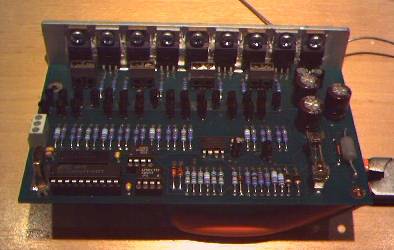
Technical details can be found under the heading of
LGB - a control.
LGB - a control.
The controller board for up to 4 functions
serves EPL switch, signal and uncoupler drives. Furthermore it supplies power to the illumination and and to the units which require AC power, like f.i. the sawmill's drive motors or the pump of the fountain located in front of the town hall. The module itself is connected to both 24V DC and the double-wire data line.
Placement on the layout
The cards are installed into commercial distribution boxes, matching the IP65 protection class (weatherproof). Placing these close to the units which need to be connected is a good choice for minimizing the spaghetti syndrome. Cables are lead into the boxes through cable glands featuring both a strain relief and a locknut. For improved protection the glands are filled with acrylic. Some of the distribution boxes are resident inside model buildings.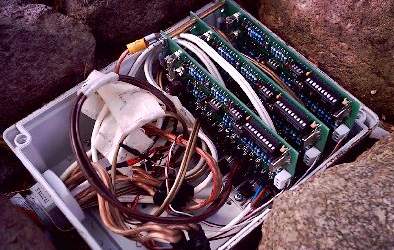
Other boxes are hidden among fieldstones.
Three cards can be found inside the box shown on the left, in other boxes up to five cards are in operation. The thick cables are used for supplying 24V DC, the stranded wires for connecting the powered units. The data connection is established via the telephone cable. Both the power supply and the data line are implemented in the form of a closed-loop.
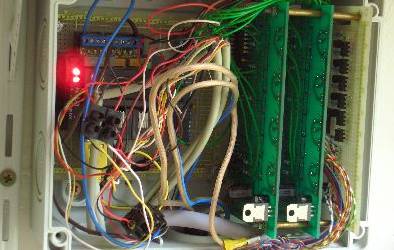
The control's central station
is a single-chip-PC (shown on the left, on the card with the LEDs), which is located in a distribution box inside the garage. Its connection to the home network is established via a twisted pair (CAT5) wiring. A galvanically isolated RS485-connection (two-wire closed-loop line) provides communication with the controller boards located in the garden. The cards on the right control the 'Jumbo'-transformers and are connected to the RS485- line, too.
is a single-chip-PC (shown on the left, on the card with the LEDs), which is located in a distribution box inside the garage. Its connection to the home network is established via a twisted pair (CAT5) wiring. A galvanically isolated RS485-connection (two-wire closed-loop line) provides communication with the controller boards located in the garden. The cards on the right control the 'Jumbo'-transformers and are connected to the RS485- line, too.
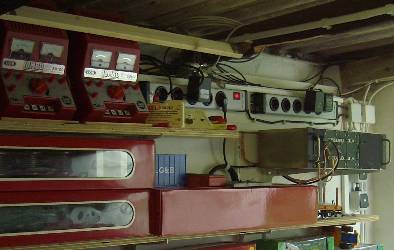
This installation's power supply
is carried out seperately for traction current and stationary powered units. The 19" plug-in module shown on the right of the picture on the left is 24V DC/30A power supply which provides power to both the control itself as well as to the powered units attached to it (illumination, turnouts, special functions). The 'Jumbo'-transformers act as power stations for the traction current, which alternatively can be provided by the self-designed traction current modules.
The 24V-supply shown in the picture on the left meanwhile has been replaced by a new device.
is carried out seperately for traction current and stationary powered units. The 19" plug-in module shown on the right of the picture on the left is 24V DC/30A power supply which provides power to both the control itself as well as to the powered units attached to it (illumination, turnouts, special functions). The 'Jumbo'-transformers act as power stations for the traction current, which alternatively can be provided by the self-designed traction current modules.
The 24V-supply shown in the picture on the left meanwhile has been replaced by a new device.
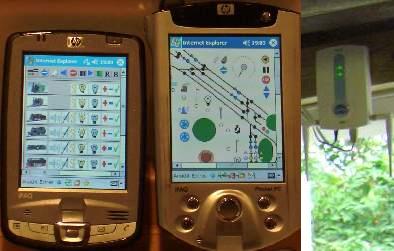
A graphical interface
based upon HTML is used to operate the layout. Thus any device equipped with a webbrowser can be utilized for this. Handhelds running Windows CE are used for operations in the garden. A Wireless LAN (WiFi) connection involving an AccessPoint (on the right side of the picture) provides a link for communications with the single-chip-PC. Alternatively (or even at the same time), any computer on the network can be used for operations - provided it has a graphical or command line-oriented webbrowser installed.
based upon HTML is used to operate the layout. Thus any device equipped with a webbrowser can be utilized for this. Handhelds running Windows CE are used for operations in the garden. A Wireless LAN (WiFi) connection involving an AccessPoint (on the right side of the picture) provides a link for communications with the single-chip-PC. Alternatively (or even at the same time), any computer on the network can be used for operations - provided it has a graphical or command line-oriented webbrowser installed.

